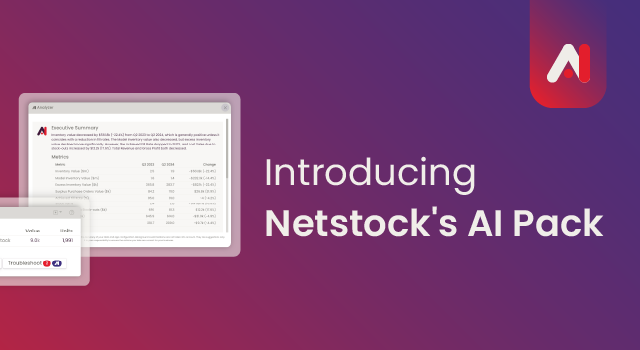Businesses should revise inventory strategies to safeguard against Red Sea disruption
The recent Red Sea attacks have sent devastating shockwaves across industries, exposing supply chain vulnerabilities and demanding quick strategic responses. From manufacturing to retail, no industry remains untouched by the repercussions of rerouted vessels and the looming Lunar New Year. The solution to meeting demand effectively is clear: businesses must always remain prepared! Proactivity, flexibility, and learning from past disruptions, such as the Suez Canal blockage in 2021, are crucial. To navigate the current sea of disruption, business resilience and a collaborative, forward-thinking approach to managing inventories are key.
Netstock’s key tips for navigating disruption
Learn from the past to prepare for the future
The six-day blockage of the Suez Canal in 2021 unleashed significant disruptions in our supply chains, leading to immediate and lingering delays upon its reopening. European ports encountered severe congestion, and ports in Asia contended with disruptions and revised schedules. Businesses must prioritize learning from past disruptions by acknowledging the profound impact on inventories and logistical processes. This proactive approach is vital for fostering resilience and implementing contingency plans through scenario planning. Armed with these insights, businesses can navigate future challenges more adeptly, cultivating a well-prepared supply chain that is highly adaptable in the face of unforeseen disruptions.
Netstock may not be able to clear the Suez Canal, reopen closed ports, or provide higher shipping capacity, but thanks to Netstock, we can anticipate the logistical impact of this incomprehensible year and activate a Plan B early enough. I can’t even imagine how we would have gotten through this year without Netstock. I would like to express my deepest appreciation for the great support we have received – Head of Purchasing, Feuerschutz Jockel GmbH & Co. KG
Focus on critical ports
Knowing that ships are being rerouted, turn your attention to the ports where cargo is being diverted to factor in extended time delays. Critical ports in Southern Africa (Gqeberha, Durban, Cape Town, Richards Bay) may face congestion due to refueling needs. Watch European ports (Rotterdam, Hamburg, Antwerp) for timing issues. U.S. West Coast Ports, especially Los Angeles, might encounter increased volumes from Asia, posing challenges despite Panama Canal restrictions. East Coast Ports could experience added pressure due to volume diversions from Panama Canal restrictions and timing issues caused by the Red Sea disruptions.
A further knock-on effect of the Red Sea disruption
Disruptions in energy and commodity markets can impact the flow of resources, affecting global markets. As more supply chain disruptions become frequent, there is a likelihood of increased insurance and shipping costs, which could have repercussions for businesses heavily reliant on international trade. In response to these challenges, businesses may reassess their inventory management strategies, placing a greater emphasis on maintaining strategic inventory stockpiles to mitigate the effects of disruptions. Given the interconnected nature of global trade, disruption has a ripple effect that can impact economies worldwide.
Build resilience through collaboration
Consider fostering collaboration within supply chain networks. Establish open communication channels with key partners, suppliers, and logistics providers. This proves invaluable for sharing real-time information about potential challenges and collectively developing strategies to mitigate risks. Developing and nurturing alternative sourcing arrangements or suppliers for commodity materials ensures businesses have backup plans for obtaining the necessary materials. By forming collaborative alliances, businesses can create a united front against supply chain disruptions. Sharing best practices, sales and inventory forecasts, insights, and resources enhances the overall resilience of the supply chain network. Additionally, this collaborative approach enables a faster response to unforeseen events, minimizing the impact on inventories and ensuring a more agile and adaptable supply chain.
Open lines of communication with stakeholders
Maintain transparent communication channels and proactively share information about potential challenges, revised timelines, and contingency plans. By fostering open and honest communication, businesses can build trust and collaboration with their stakeholders, allowing for a more coordinated response to disruptions. Understanding customers’ and suppliers’ evolving needs and concerns enables businesses to make informed decisions, adjust inventory strategies, and collectively navigate the impact of supply chain disruptions. Open lines of communication create a sense of shared responsibility, reinforcing the resilience of the entire supply chain network.
Adapt inventory planning
It may be difficult to predict demand and forecast the right amount of inventory needed right now. Businesses need visibility and a flexible contingency plan for their inventory replenishment to adjust to potential disruptions while safeguarding profits! Adapting inventory planning boils down to the visibility of inventory and supplier performance. A single view of inventory holding will identify the products to focus your attention on—for example, which items are about to stock out due to extended lead times- and then adjust the safety stock to accommodate the shortfall to meet demand. Visibility into supplier performance is valuable because it enables demand planners to be proactive and respond promptly to disruptions rather than merely reacting after the fact.
When Netstock customers receive a message that their lead time will increase by two weeks, for example, Netstock will easily recommend what they should order in the next two weeks all at once, which will minimize the ongoing impact of supply chain disruptions – Barry Kukkuk, CTO and co-founder at Netstock
Embrace inventory management solutions for future-ready supply chains
Embracing inventory management solutions with AI capability, is crucial for building resilient and adaptive supply chains. These tools provide real-time visibility into inventory movements, enabling businesses to optimize stock levels, forecast demand accurately, and proactively address disruptions. Additionally, the ability to forecast future inventory needs will assist in financial planning, including budgeting for 3PL and shipping costs. Adopting inventory management solutions empowers businesses to make informed, data-driven decisions, ensuring a streamlined and future-ready supply chain that can effectively navigate challenges like disruptions in the Red Sea.
By partnering with Netstock, you can be confident that your business is prepared to weather any storm. Take the first step towards supply chain resilience and reach out to Netstock today!




